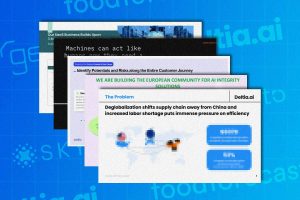
Model-Driven Apps are transforming the way companies develop and manage their software applications. As a central part of Power Apps, they provide an effective platform for building business applications without any programming knowledge. In this guide, we will explore the basics of Model-Driven Apps and show you how to use them to develop customized applications for your company.
Table of contents
- What are model-driven apps?
- Why Model-Driven Apps?
- Security roles and data access in model-driven apps
- How to create a model-driven app?
- Application scenarios for model-driven apps
- Integration with other tools
- Conclusion
What are model-driven apps?
Model-Driven Apps are modern business applications based on data models. In contrast to traditional development methods, no extensive programming requiredThey enable users to integrate and model data from various sources such as Microsoft Dataverse, SharePoint and SQL Server. By using ready-made data models and a user-friendly interface, Model-Driven Apps can can be created quickly and adapted to individual requirements.
Why Model-Driven Apps?
Using Model-Driven Apps offers numerous benefits, including rapid development, customizability, integration with other tools, and device independence. These apps enable companies to create more efficient business applications that meet their exact needs without spending a lot of time and resources.
Model-Driven Apps mit CONET
We digitize and automate your processes, uncover problems, resolve them and help you increase employee satisfaction. Contact us so that we can digitize and effectively design your business processes with the business applications of Microsoft Power Platform and Microsoft Dynamics 365. You can find out more about the services we offer on our homepage.
About our services
Security roles and data access in model-driven apps
In model-driven apps, security roles are crucial to ensure To ensure confidentiality and integrity of dataThese roles allow you to precisely control access to sensitive information and ensure that only authorized people can access it. This can be like a digital key system where certain people have access to certain areas based on their roles and responsibilities in the company.
This is particularly important today, as data protection and legal compliance are playing an increasingly important role. Model-Driven Apps not only allow customized applications to be created, they also ensure data security.
How to create a model-driven app?
Creating a model-driven app takes three steps:
- Data modeling: Defining data sources and modeling in a unified schema, integrating various data sources such as Microsoft Dataverse, SharePoint and SQL Server.
- App creation: Use Power Apps Studio to design the user interface. The user-friendly drag-and-drop interface allows you to create forms, views and dashboards based on the defined data models. Predefined controls and templates allow you to extend and customize the functionality.
- Customization and deployment: Further customization of the app, including adding business logic, validations, and workflow automations. The app is then prepared for deployment, either to internal users or external customers and partners.
Application scenarios for model-driven apps
- Sales and Marketing: Customer relationship tracking, lead management and sales opportunity optimization.
- Customer service: Efficiently handle service requests and organize customer interactions.
- Compliance and risk management: Automating compliance processes, conducting audits and identifying risks.
- And many more …
These examples illustrate the wide range of possible applications in different areas of the company. But the adaptability does not end here – the flexibility of model-driven apps enables companies to develop tailor-made solutions for other application areas that meet specific requirements and processes.
Integration with other tools
Model-Driven Apps also integrate seamlessly with a variety of other tools. This integration allows companies to streamline workflows and improve collaboration between different teams and departments. Here are some ways they can be integrated with other tools:
- Microsoft 365 applications: Model-Driven Apps integrate seamlessly with Microsoft 365 applications such as Outlook, Excel, and Teams, enabling seamless collaboration and easy data sharing between applications.
- Automation tools: By integrating with automation tools like Power Automate, business processes can be automated and efficiency increased. This allows repetitive tasks to be performed automatically, saving time and resources.
- Business Intelligence Tools: Model-Driven Apps can also be integrated with business intelligence tools such as Power BI to analyze data and make informed business decisions. By integrating Power BI tools, companies can gain insights and identify trends that help optimize business strategies.
- Discover the flexibility of Copilot in Model-Driven Apps: Copilot is another innovative feature integrated into Model-Driven Apps. The AI-based assistant provides a user-friendly way to navigate through the application and retrieve relevant information. By using Copilot, users can work more efficiently and take advantage of the full flexibility of Model-Driven Apps.

These integrations enable companies to streamline workflows, manage data efficiently, and improve collaboration across different teams and departments.
Conclusion
Model-Driven Apps are the key to companies' future viability. They offer a simple and effective way to develop customized applications without requiring extensive technical knowledge. Their user-friendliness and ability to integrate enable companies to optimize their business processes and quickly adapt to new requirements. In short: Model-Driven Apps are a sensible investment for any company that wants to increase its efficiency and remain competitive.
Model-Driven Apps mit CONET
We digitize and automate your processes, uncover problems, resolve them and help you increase employee satisfaction. Contact us so that we can digitize and effectively design your business processes with the business applications of Microsoft Power Platform and Microsoft Dynamics 365. You can find out more about the services we offer on our homepage.
About our services
Was this article helpful for you? Or do you have further questions about model-driven apps? Write us a comment or give us a call.

Atakan Chousein Oglou supports the Microsoft Business Applications department at CONET Solutions GmbH as a working student.
Source: https://www.conet.de/blog/model-driven-apps-ihre-geschaeftsanwendungen-ihre-regeln/


